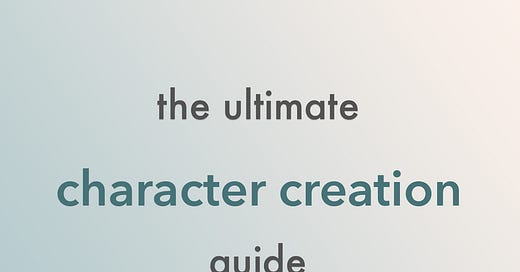Learning Objective: By the end of this post, you will know how to create active protagonists by outlining their (1) desires, (2) obstacles, and (3) key decision points with six guiding questions.
Last month, I shared the published draft of a short story that I wrote, revised, and sold in five days. Today, we’re doing a deep dive into the one-page outline I used to develop the characters and conflict in this story. I first learned this outlining technique in Roberto Busó-García’s screenwriting class in 2014. Over the last ten years, I’ve modified this outline to best suit my story development needs as a novelist, short story writer, and video game narrative designer. For the last decade, I have used the One Pager to outline everything I write from short stories like “Breathe for Them Both” to video games like Space Frontier and novels like my forthcoming book, Good People.
In using the One Pager to develop my character’s desires and the obstacles in their way, I can also identify key decision points in their story that will lead them to the transformation necessary for them to literally or metaphorically survive the end of the story. Since this outline helps me forecast each character’s narrative trajectory, I can avoid sinking time into meandering drafts that will likely get thrown out in revision. The One Pager ultimately gives me a map to the story I want to tell. Thanks to this map, I have the freedom to spend more time doing the kind of writing that matters most to me (scene craft and dialogue) and less time doing the kind of writing that doesn’t come naturally to me (plot development and structure). This craft lesson will teach you how to use the One Pager and its six guiding questions to streamline your drafting process.
As always, take what’s useful; leave what’s not.
The Passive Protagonist Problem
For years, the early drafts of my stories often received feedback that looked something like this:
Things happen in this story, but it’s difficult to see the cause and effect of these events and why each event matters to the protagonist.
The protagonist doesn’t have enough agency.
The protagonist is reacting to the story and not taking action.
The story is happening to the protagonist.
The narrator has an interesting voice and the dialogue is witty and effective, but the story feels random and aimless.
All this feedback ultimately translates to one thing: the protagonist is passive. A passive protagonist drifts through the story world. They respond to brief moments of conflict or change that are often easily resolved in a single scene. They banter humorously—sometimes dramatically—with other characters, but there is little to no tension because the stakes of the conversations are unclear. Instead of pursuing a goal that solves a problem in their life, a passive protagonist lacks agency. This lack of agency makes the chronic tension of the story lax. Without overarching desires and obstacles to connect each paragraph, scene, or chapter, a story presents little reason for the reader to turn the page.
In western storytelling, effective stories do not make the reader ask, “What will happen next?” Effective stories make the reader ask, “What will the protagonist do next?” This question creates chronic tension and keeps the reader reading. The One Pager outlines chronic tension by asking six (6) guiding questions that develop your protagonist and their story in six (6) key craft areas:
The Protagonist’s Backstory
Character Goals
Story World
Inciting Incident
Antagonism
Crisis Decision
We’ll be breaking down these six craft elements with examples from “The Era” by Nana Kwame Adjei-Brenyah, Black Panther (2018), and the short story I shared last month. Spoilers are ahead. You can read “The Era” for free here and my short story for free here. Let’s jump in.
The One Pager
Keep reading with a 7-day free trial
Subscribe to Craft with Kat to keep reading this post and get 7 days of free access to the full post archives.



